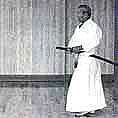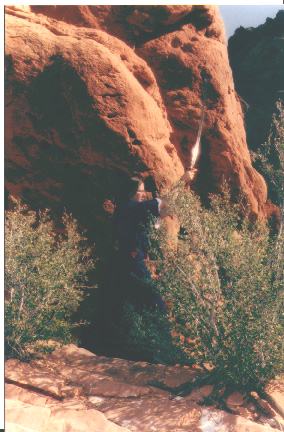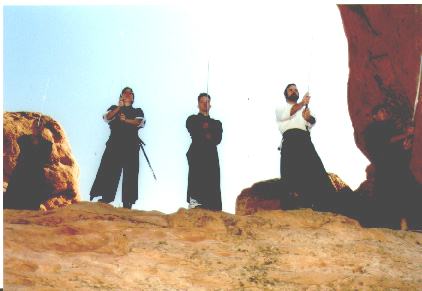Iai Batto Jutsu and the Japanese Sword
Iai Batto Jutsu is a very graceful, yet deadly, art of the Japanese sword. It deals with drawing the sword out of the scabbard with lightening speed, cutting your enemy, then shaking the blood off your blade, all in one fluid motion. There are also many different types of cuts and kata (combinations of movements). So why do I study it? It obviously has no practical value since people don't run around with swords anymore. The reason is that it is so beautiful to watch and do. Plus, it is an ancient art that has a whole lot of tradition and history. Much of practice deals with samurai formalities and attention to detail, which will help in my military career. It's a very relaxing art, one that lets you get away from the real world for an hour or two. It is very similar to Iaido, except that Iaidoka don't actually cut things, they just perform the motions. Batto justu arts consist of actually cutting targets of rolled tatami (floor mats), straw, or bamboo. Although they are both art forms, Iaido is slightly more ethereal while Iai Batto Jutsu is more historical. Kendo is another Japanese sword art, but it deals with the fencing aspects of sword use. Samurai practiced many different art forms, including kyu jutsu (archery), music, tai jutsu (empty-handed combat), sumi-e (painting), and the aforementioned ken jutsu styles (swordsmanship).

One Sunday morning my dojo had a class at Garden of the Gods, which is a cool state park in Colorado Springs. Here are a few pictures from there. They're not great quality scans, but they're low on memory, so don't complain :)
Here's my sensei performing a cut in the morning sun:
I call this shot "Five Warriors":

Here's a nice group photo with the mountains in the background:

Back when I was a cadet, my dojo hit a major speedbump. My sensei was kicked out of the Air Force for medical reasons. It was all very unfair and quite sad. We all hated to see this happen to such a great person. She now resides in Japan, and I believe she is happy, finally, because of her love of the Japanese culture and the Japanese sword. Ganryu, if you read this, please e-mail me to let me know how you're doing!
A while ago my sensei came back to the Academy for a visit, and to see how the dojo was doing. See, after she left, she wanted me to teach the classes and keep everyone up to speed with the art. Well, I'm happy to say that she was pleased with our progress. We did a demonstration here, including a cutting demonstration by her. I think it all went well. More importantly, we spent about a week practicing while she was here. I learned a lot, along with everybody else in the dojo. She even gave a few of us cards that say that we are members in the Soga Ryu dojo in Japan. I am honored to hold the card, and hope to someday go to Japan to train with Soga-sensei (my sensei's sensei) in his dojo. For now, I'll have to continue to practice on my own.
The sword once meant a great deal to the Samurai of older Japan. In 1876, the wearing of swords was forbidden in the streets of Japan, so the Samurai class was officially ended. Today, however, the sword still has a significant impact on the minds and hearts of many Japanese and non-Japanese people around the world.
The most common type of Japanese sword seen today, the katana, is made as the product of an ancient art that refined its technique throughout the centuries to develop a blade that is as sharp as a razor on the edge, but softer in the middle to better absorb impacts. This seems like a contradiction because steel has to be hard to have a sharp edge, but soft so that it is not so brittle it breaks on impact. The Japanese swordsmiths figured out a way to weld a jacket of hard steel (high carbon content) around a core of soft steel (low carbon). This hunk of metal was then stretched and formed into the shape of a sword.
Many people have heard of the step in the process when the smith "folds" the steel. This part happens early on in the process, and is needed for the outer, harder steel of the blade. The purpose is to make the chunks of steel received from the smelter usable. The smith takes many small chunks of steel and heats them up, pounds them flat, then folds it in half. This is repeated many times until the steel has the proper characteristics. It is often folded more than 4 times, but not usually more than 16. Some say that the more folds the better, but this is not true. It is up to the smith to determine how many folds a particular batch of steel requires. If it is folded too many times, the steel becomes too homogenized, which is not good for impact absorbing qualities. If it is not folded enough, however, the steel will have holes, soft spots, and brittle spots. It's a fine balance, which is why swordsmiths must go through rigorous apprenticeship before they are allowed to make their own blades.
Another step that many people know about is the "tempering" of the blade. Without getting too technical, I'll try to explain this step. When the blade has the final shape, it must then have its edge hardened so that it can take a good, sharp edge. This is done by coating the entire blade with a clay mixture. The clay is thick on most of the blade, except near the edge. It is made very thin along the edge (where the heat-treating and tempering must happen). The thick clay insulates the steel, while the very thin clay actually helps the fire's heat to evenly and quickly (due to surface area) heat up the blade. When the clay is dried, the smith puts the blade in the fire and waits until it has reached a very specific color. It is usually a nice glowing orange color (though the smith would have a much more descriptive term) when it is ready to be dunked in water. In a very exciting moment, the smith pulls the blade out of the fire and places it into the water. This "heat treats" the edge of the blade, which basically means the steel becomes very hard. It is also very brittle at this stage, so the smith must do one more step, called tempering. This requires him to heat up the blade again, but not as hot as before, then soak it in water one more time. This step relieves some of the stress in the steel, allowing a strong, but hard, edge.
The next step was to polish the blade. This often takes about 2 weeks because of the great care that is put into it. Japanese sword polishers must have great patience, and have a lot of knowledge of steel so that they do not ruin the blade that the smith made. The polishers do not just smooth out the steel, they also sharpen the edge of the blade.
After the blade is finished, the rest of the furnishings are made to fit the blade. It is then all put together and a shinken (new sword) is born.
Someday I hope to develop this page to furthur to explain what the sword means to the Japanese people and how it is made. For now, though, I'm going to concentrate more on the thought page.
Last modified: 15 December 1999




